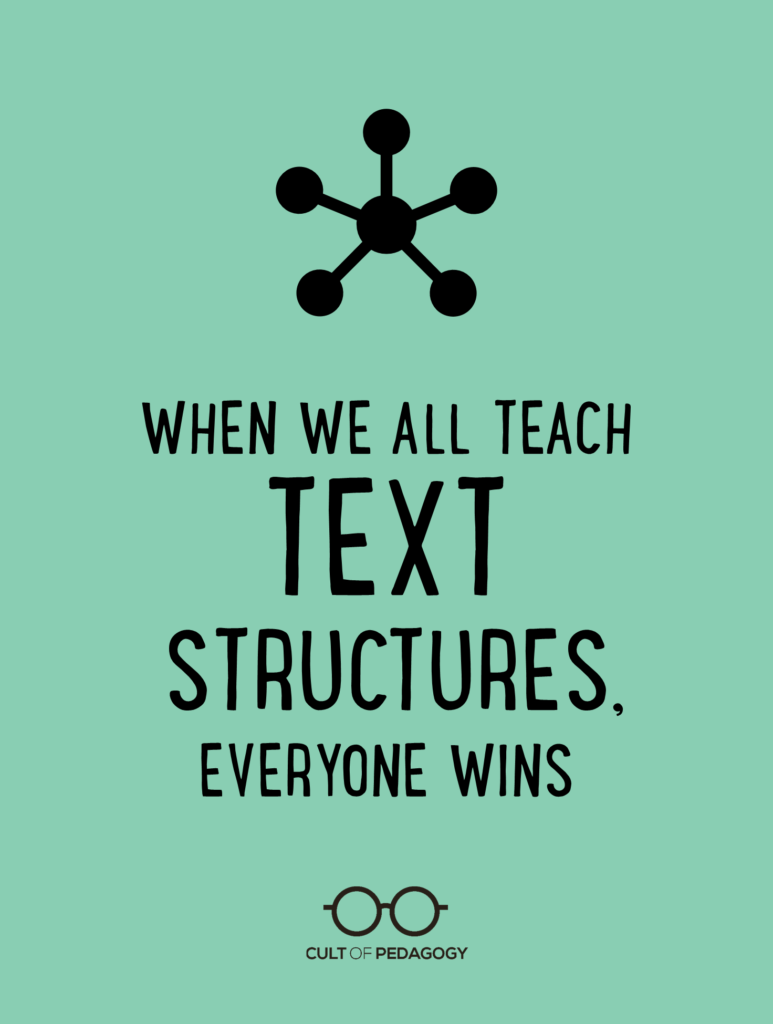
It’s a given that we want our students to read well.
We want them to handle challenging material strategically, to comprehend all of its nuances clearly, to break it down and analyze it, and more than anything, to remember what they read.
Lately, the mandate to support student reading has been directed outside the English language arts classroom: Teachers of history, science, and other subjects are now expected to weave literacy instruction into their teaching of content. But how should they do that? What are the most effective ways to help students learn to read challenging content-area texts?
One way is to teach them text structures. This is different from text features — the headings, subheadings, and supporting visuals that writers use to highlight key points. A text structure is its overall organization: Common text structures are cause and effect, sequence, and compare/contrast. And research shows that when students are explicitly taught to identify text structures while they read, they understand the material better and retain more of it after reading (National Institute for Literacy, 2007).
This video shows you how to teach text structures:
Tools to Get You Started
Graphic Organizers
Teaching text structures is much easier with the help of graphic organizers. The organizers featured in this video, along with several others, are included in this Graphic Organizer Multi-Pack, available now in my Teachers Pay Teachers Store.
Signal Terms
Students will be able to identify text structures more easily if they become familiar with signal terms, words and phrases that frequently occur in certain types of texts. Here’s a free chart from the University of Tennessee’s Center for Literacy, Education & Employment that shows common text structures with their signal terms: Informational-Text-Structures
Further Reading
What Content-Area Teachers Should Know About Adolescent Literacy
National Institute for Literacy, 2007
Every teacher interested in supporting students’ reading and writing should grab a copy of this free 61-page PDF. It includes the strategies mentioned here, plus dozens of others for supporting student reading and writing in the content areas.
20 Strategies to Teach Text Structure
Kristi Orcutt, ESSDACK.org
This PDF provides some fantastic ideas for teaching students how to recognize text structures and use them to improve their comprehension.
If you found this article useful, I’d love to have you come back for more. Join my mailing list and get weekly tips, tools, and inspiration — in quick, bite-sized packages — all geared toward making your teaching more effective and joyful. To thank you, I’ll send you a free copy of my new e-booklet, 20 Ways to Cut Your Grading Time in Half. I look forward to getting to know you better!

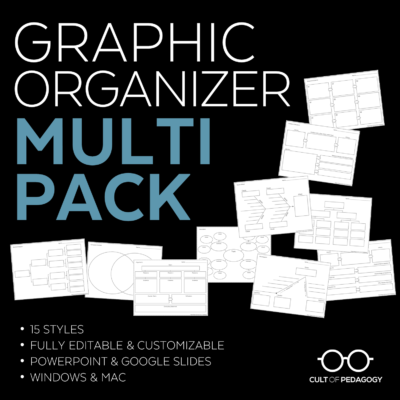
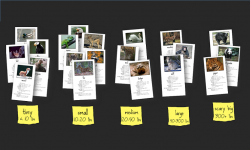
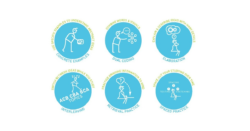

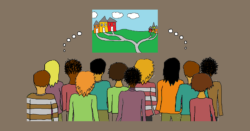
I finally looked at this, and it is excellent. Seriously. I am actually using a graphic organizer in my current unit, and the part where you show the teacher referring back to that and filling it in as she goes is brilliant. I’m changing my lesson immediately. Also, I love the different colored types of text structures. I need a screenshot of that!
Thanks, Ab! I added the colors just to make the video pretty, but they would actually be hard to fill out if you printed them out from a colored original. Do you think it would be useful for teachers to have little colored posters of the text structures to hang on their walls, as a way to reference them when talking to students? That would be pretty easy to put together.
I can only speak for myself, but yes! Any graphic anything that can be made simpler is better. The colors just help to visually differentiate the types.
Jennifer, do you have any specific non-fiction passages that work well with these graphic organizers? Or a list of websites? I would love to know what your favorites are…
That’s a great question! I can’t think of any specific passages off the top of my head, but you have given me a great idea for a future blog post — I’ll see what I can dig up. What grade level do you teach?
I teach 6-8 ELA… I will look forward to your post 🙂
I teach Language in 4th form.
Check out commonlit.org. It’s AMAZING (and free)!
In the first term of the first year in grammar school (they existed in those days), in the Latin class, we did box analysis. This gave me the knowledge and experience to deal with relative clauses, which are some of the things that scientific writers use to excess. Very useful. Pre computers!
I guess this is the way to make an easy move for my daughter to help her study. Very useful, really. Thanks!
It is so good for teaching metodology.
Hey, Jennifer. THIS IS A FANTASTICCCCCCCC resource. You clearly presented what a text structure is and why it help students use the to understand non-fiction text. I’m grateful that you provided so many text structures in your video (description, sequence, cause and effect, argument, and problem and solution.
I’m going to update two of my blogs to this article. I wrote one about creating concepts maps to help synthesize the non-fiction text http://www.empoweringells.com/2016/09/24/a6-teaching-inferencing/. I’ll link this video to it so that readers can find more example of text structures.
I love your resources becayse they’re so clearly communicated. No fluff. Just strategy and reasoning. I bet you spend hours on creating the content and especially the video. Hours of editing.
THANK YOU for your contribution to the field.
If you’ve never checked out “Notice & Note: Nonfiction”, you should. They do a good job in there of discussing text structures as well, including ideas for ways to teach them.
This is so great. Anything that simplifies reading and writing is good in my book! So many people see it as this nebulous inaccessible thing–and it’s not always that way. I think that there are a lot of subject area teachers who would like to take on more literacy but just don’t know how.
I teach a group of teachers and would be interested in buying 48 packets of the graphic organizers. Is there a price break for this many packets?
Hello,
Your video shows a table with the different words each text structure uses. Do you know where I can get this table from?
Thank you,
Tanya
Tanya, here’s a link to that chart. You can also find a link at the bottom of the blog post. Hope it helps!
I just purchased your graphic organizers on TPT and did not get what I expected. I was expecting a google doc or a word doc that I could actually used with my students. While I think the ideas are great, I want something I can use with the kids right now. I was already creating my own but it is time consuming.
Hi Beth. The reason these come in PowerPoint and Google Slides files is because those programs are much better for manipulating shapes and lines. It is much harder to do this in Docs and Word. But students can easily add text to these digitally! As long as they have their own copies, all they need to do is go to the “Insert” menu, choose “Text Box,” and put a text box inside any shape where they want text. For both the Google Slides and PowerPoint versions, I have included video tutorials that show you how to work with text boxes. I wanted to make the organizers themselves editable, so I chose to use shapes instead of text boxes, but those can easily be added on in seconds.
If you need more help, please contact us at support@cultofpedagogy.com
Can you please let me know how I can subscribe to your website.
Hi Judi,
Just click this link to subscribe!
In the “Further Reading” section, the link for the “20 Strategies to Teach Text Structure” by Kristi Orcutt at ESSDACK.org is dead.
A quick Google search shows the document can now be found with the following URLs:
https://education.illinoisstate.edu/downloads/casei/3-01-04-handout%20TextStructureResources%201.pdf
http://www.dr-hatfield.com/EDUC536/docs/StrategiesforTeachingTextStructure.pdf
There’s also a whole presentation by Kristi Orcutt on text structures that can be found at:
https://www.literacyleader.com/sites/default/files/Text%20Structure%20GCHS.ppt.pdf
In the video, I was particularly inspired by directly pointing out super- and subordinate text structures for more complicated texts. I will play with this in having my students recognize the structure of arguments in “The Social Dilemma” documentary as many claims include descriptions of concepts that are introduced to the audience. The advice to partially complete organizers for students will help with this. If we mark sections as being a subordinate structure in a larger argument or other superordinate structure, limit the possibilities, and present students with key words (at the high school level), I think they can reasonably determine on their own what the subordinate structure is and why it was necessary to convey that information to the audience. I belive this really helps to give students a stronger tool to predict the deep framework of texts, and therefore be more able to map that argument into their own understanding as well as borrow elements of it for their own writing. Exciting ideas!
To make this physical, you might be able to blow up individual slides with the graphic organizers into a poster-sized paper. Then, a half or full sheet of the subordinate structure may fit into the larger-sized superordinate structure. This could help make the delineation more tangible and physical in order to convey it to students.
Thank you for sharing those ideas! We will work on getting that broken link updated. We appreciate you bringing it to our attention.